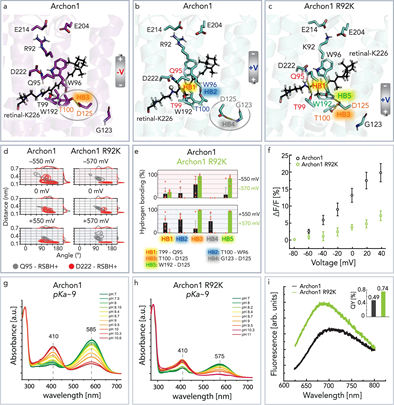Four subprojects of SFB 1078 published a joint paper in Nature Communications
Voltage sensing in Archon1
Image Credit: Silapetere A. et al., Nat. Com. (2022)
Together with colleagues, SFB 1078 PIs Peter Hegemann (TP B2), Han Sun (TP C8), Ulrike Alexiev (TP A2), and Peter Hildebrandt (B6) and their coworkers shed new light on the molecular basis of fluorescence in microbial rhodopsins named QuasArs and their peculiar voltage sensitivity using a combination of spectroscopic studies and molecular dynamics simulations which reveal a unique photoreaction scheme and voltage-dependent changes of the hydrogen-bonding networks. The results pave the way for the development of next generation voltage sensors for optogenetics applications and were recently published in the September issue of Nature Communications.
News from Oct 18, 2022
Rhodopsins had long been considered non-fluorescent until a peculiar voltage-sensitive fluorescence was reported for archaerhodopsin-3 (Arch3) derivatives. These proteins named QuasArs have been used for imaging membrane voltage changes in cell cultures and small animals, but they could not be applied in living rodents. To develop the next generation of sensors, it is indispensable to first understand the molecular basis of the fluorescence and its modulation by the membrane voltage. Based on spectroscopic studies of fluorescent Arch3 derivatives, we propose a unique photo-reaction scheme with extended excited-state lifetimes and inefficient photoisomerization. Molecular dynamics simulations of Arch3, of the Arch3 fluorescent derivative Archon1, and of several its mutants have revealed different voltage-dependent changes of the hydrogen-bonding networks including the protonated retinal Schiff-base and adjacent residues. Experimental observations suggest that under negative voltage, these changes modulate retinal Schiff base deprotonation and promote a decrease in the populations of fluorescent species. Finally, we identified molecular constraints that further improve fluorescence quantum yield and voltage sensitivity.
Silapetere, A., Hwang, S., Hontani, Y., Fernandez Lahorem, R. G., Balke, J., Velazquez Escobar, F., Tros, M., Konold, P. E., Matis, R., Croce, R., Walla, P. J., Hildebrandt, P., Alexiev, U., Kennis, J. T. M., Sun, H., Utesch, T., and Hegemann, P. (2022). QuasAr Odyssey: the origin of fluorescence and its voltage sensitivity in microbial rhodopsins. Nat Commun, doi: 10.1038/s41467-022-33084-4.
